What Is a Squatted Truck? Why Are They So Popular?
August 3, 2023
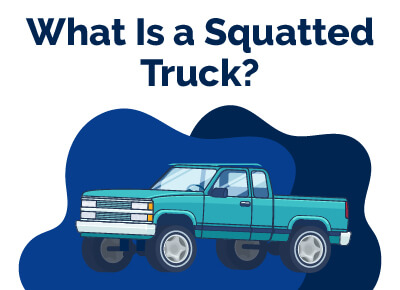

Michael Collado is a car buying expert and has been a professional automotive writer since 2009. He’s written about dealership sales, vehicle reviews and comparisons, and service and maintenance for over 100 national automotive dealerships. Previously, Collado was a copywriter at the ad agency TBWA/Chiat/Day where he worked on brand campaigns for Nissan, ABC Television, Sony PlayStation, and Energizer. His recognition in the ad industry includes awards from Communication Arts and The Clios.
Collado has a Bachelor’s degree from the University of South Florida, with a major in Psychology and a minor in Marketing.
It's a question that can ignite passionate debates among vehicle enthusiasts.
Squatted trucks, with their distinct high-front and low-rear stance, are turning heads on highways across the country.
But what is it about these modified pickups that makes them so controversial yet undeniably popular?
Table of Contents
The Aesthetics and Mechanics of Squatted Trucks
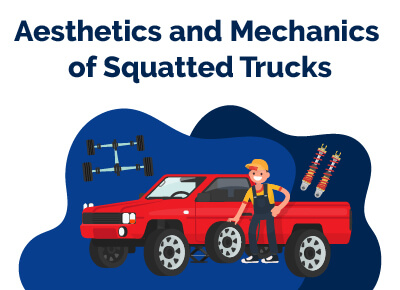 Squatted trucks, a trend that has swept across the automobile world, have sparked curiosity among many. This unique truck style is characterized by a raised front end while the rear remains at its original height or even lower.
Squatted trucks, a trend that has swept across the automobile world, have sparked curiosity among many. This unique truck style is characterized by a raised front end while the rear remains at its original height or even lower.
This alteration in design isn't merely for aesthetics; it also significantly changes how these pickup trucks handle on-road conditions. The modification involves installing a lift kit to elevate the front end, which transforms standard trucks into squatted vehicles with an unmistakable profile.
Origin of Squatting Trucks
California's Baja Racing Circuit, known for its challenging sand dunes and jumps, was where squatting trucks originated. Drivers found that raising their vehicle's front ends improved landing after leaps over sandy terrains during desert racing events.
A lifted front end allowed more suspension travel when landing from high jumps, a necessity in California's Baja racing circuit, thus reducing impact damage to both driver and vehicle. These modified desert racers were then adapted by fans outside inland California who admired this distinctive look but used them primarily as passenger trucks rather than competition machines.
In essence, what started as practical modifications designed to land jumps safely evolved into an aesthetic statement, adopted widely beyond assembly line automakers, engineer trucks standards the birthplace of squatted truck owners’ culture today.
Moving forward, we will delve deeper into the costs associated with modifying your own brand-new truck to achieve this unique stance...
The Cost and Process of Modifying Squatted Trucks
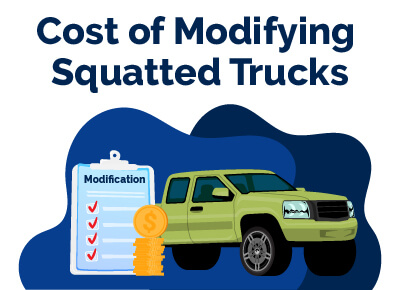 Modifying standard trucks into squatted vehicles can be an investment, with costs ranging from as low as $300 to well over $10,000.
Modifying standard trucks into squatted vehicles can be an investment, with costs ranging from as low as $300 to well over $10,000.
This price variation largely depends on the type of pickup truck being modified and the extent of work required for transformation.
While some truck owners buy basic lift kits for a few hundred dollars, others opt for comprehensive modifications that involve high-end parts and professional installation services.
Lift Kits and Their Installation
A critical component in creating squatted trucks is the lift kit.
These are specially designed packages containing all necessary components, such as raised front-end springs or spacers, shock absorbers, and control arms, among other elements needed to raise your vehicle's front suspension system while leaving rear springs at their original height or even lower.
In essence, the goal is achieving a 'squat' where the rear end remains significantly lower than its lifted counterpart is up-front - hence why they're also known colloquially as a Cali Lean or a Carolina Squat.
To install these kits, you would typically need specialized tools along with mechanical expertise; however, many choose to have them professionally installed due to the complexity involved.
Bear in mind, though: While this modification gives your automobile that distinct squatting look, it may put additional strain on certain components like drivelines, rear axles, and tires because weight distribution becomes unevenly skewed towards the backside resulting from the lifting process.
Making Modified Trucks Legal- Or Not?
You might wonder about the legality surrounding these types of alterations, given potential safety concerns arising out thereof. In fact, two states - Virginia and North Carolina - have already passed laws banning squatted vehicles citing reasons related to road-safety hazards posed by reduced visibility forward direction coupled with decreased ability to handle corners effectively, especially under load conditions. Herea€™s more information regarding those regulations. However, in most places across the US, it still remains perfectly legal own drive one provided it meets local vehicular standards requirements.
The Controversy Surrounding Squatted Trucks
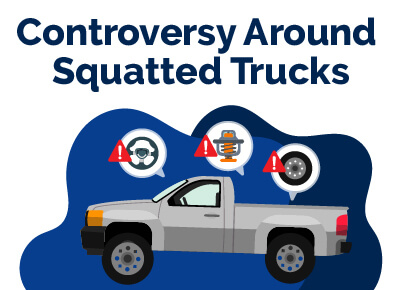 When it comes to squatted trucks, opinions are often divided. The distinctive truck style has its share of admirers and critics alike.
When it comes to squatted trucks, opinions are often divided. The distinctive truck style has its share of admirers and critics alike.
Decreased Visibility: A Major Concern for Squatted Truck Owners
A primary concern with squatting trucks is the decreased visibility that results from a lifted front end. Studies show this modification can significantly impair the driver's ability to see pedestrians or smaller vehicles directly in front of them.
This reduced forward visibility not only poses risks for other road users but also challenges on-road safety norms. Despite these issues, many people drive squatted trucks as they consider it an expression of individuality and personal style.
Poor Cornering Ability and Diminished Weight-Carrying Capacity
Squatted vehicles aren't just about aesthetics; their functionality is equally affected by modifications made during the assembly line production process by automakers engineer trucks. For instance, when you lift the front end while keeping or lowering rear springs, there's a significant impact on cornering abilities due to changes in suspension system geometry.
In addition, most pickup truck owners buy these passenger automobiles primarily because they're designed to carry weight efficiently - something compromised when one opts for Carolina squat. This means your standard brand-new truck could lose some utility value after having lift kit installed.
As we delve deeper into understanding why banning squatted vehicles becomes necessary at times, let us remember that every trend has two sides - those who love it passionately despite drawbacks others find unbearable.
The Popularity and Criticism of Squatted Trucks
 Despite the safety concerns surrounding squatted trucks, many people drive these modified vehicles as a form of self-expression.
Despite the safety concerns surrounding squatted trucks, many people drive these modified vehicles as a form of self-expression.
This unique truck style has garnered popularity across different regions in the United States with various names such as "Carolina Squat," "California Lean," or "Cali Lean."
Social Media Influence on Squatting Truck Trend
Social media platforms like TikTok have played a significant role in popularizing this trend among younger audiences.
Videos featuring squatted pickup trucks often go viral, inspiring more truck owners to modify their standard trucks into squatting ones.
In addition to showcasing videos of these uniquely styled automobiles, online communities provide forums where enthusiasts can exchange ideas about lift kit installation and share experiences related to owning and driving squatted trucks.
Not all are enthused about this emerging fad.
Critics argue that modifying brand-new trucks into squatting ones could compromise driver’s ability due to reduced visibility from raised front end.
Furthermore, there are claims that rear suspension alterations may affect how well passenger trucks carry weight.
It's clear, though; whether you're an advocate for banning squatted vehicles or an enthusiast who loves showing off your Cali lean at car shows, one thing remains constant: The debate around automakers engineer-ing their assembly line-produced inland California desert racers isn't ending anytime soon.
Prospective Future for Squatted Trucks
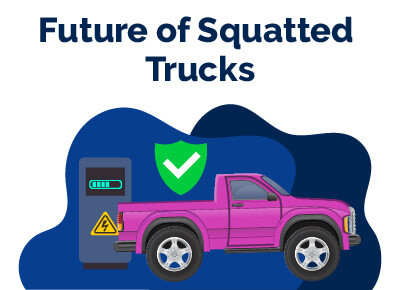 The popularity of squatted trucks among certain demographics is undeniable.
The popularity of squatted trucks among certain demographics is undeniable.
Despite the drawbacks and increasing legal restrictions, many truck owners buy these modified vehicles as a statement of individuality.
Possibility of Factory-Installed Lifts in Brand-New Trucks
A question that arises from this trend is whether automobile manufacturers might start producing brand-new trucks with factory-installed lifts to be functional and safe on-road vehicles right off the assembly line.
If they were to introduce lift kits into their manufacturing process, it would certainly appeal to those who prefer the aesthetics of squatted pickup passenger trucks without having to modify them post-purchase.
Trends Influenced by Legal Restrictions
Legal restrictions, such as those currently enforced in Virginia and North Carolina, could also influence future trends.
- Certain states may follow suit, making modified squatting illegal, which can affect sales numbers significantly.
- In contrast, areas, where no specific laws exist against squatting, could see an increase in demand for both pre-owned lifted front-end models or new ones directly from automakers if made available.
Social Factors Impacting Trends
Youth culture plays a significant role here - younger audiences are more likely influenced by social media platforms like TikTok showcasing videos featuring these unique vehicle modifications, thus driving up interest levels considerably over time despite potential safety concerns or legal implications involved with owning one such vehicle.
Best Car Deals by Category
Frequently Asked Questions
What is the point of a squatted truck?
Squatted trucks are often modified for aesthetic reasons, to stand out or express individuality. The trend originated from Baja racing where it served a functional purpose in improving landing after jumps.
Why are Carolina squat trucks illegal?
Carolina squat trucks are illegal due to safety concerns. They can decrease driver visibility and impair cornering ability, posing potential risks to pedestrians and other road users.
What are the issues with squatted trucks?
The main issues with squatted trucks include decreased forward visibility, poor cornering ability, diminished weight-carrying capacity in the bed, and possible strain on vehicle components due to uneven weight distribution.
What states have outlawed the Carolina squat?
The states that currently have laws banning squatted vehicles are Virginia and North Carolina.
Posted in Car Research & Comparisons |




